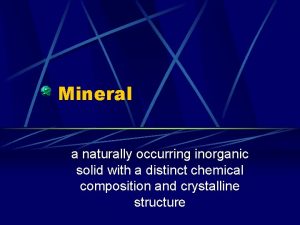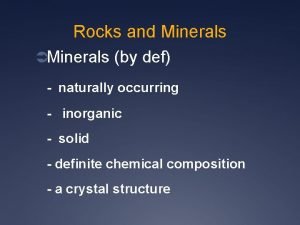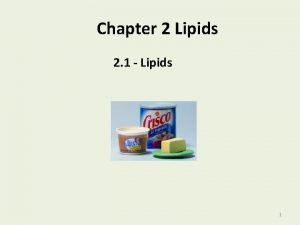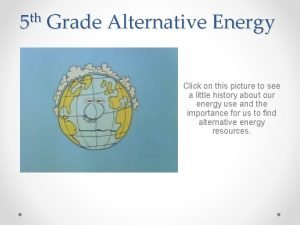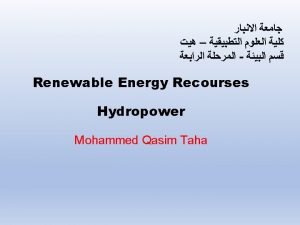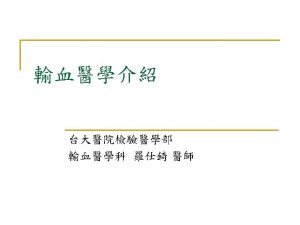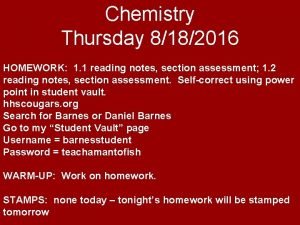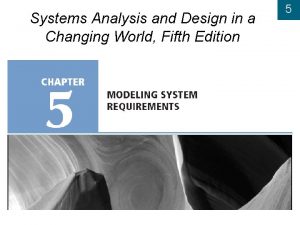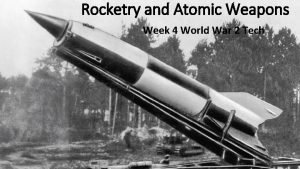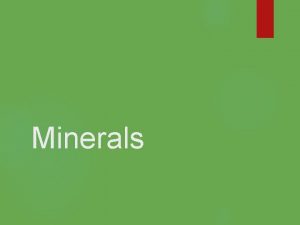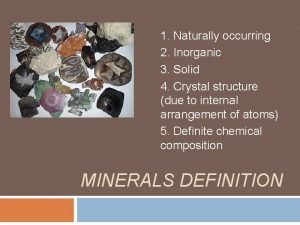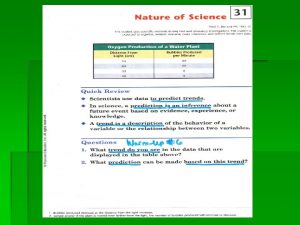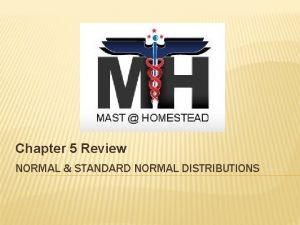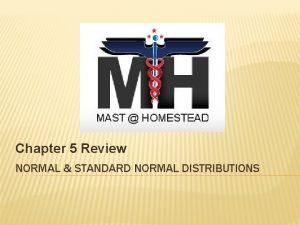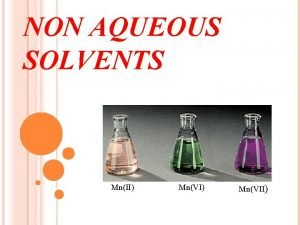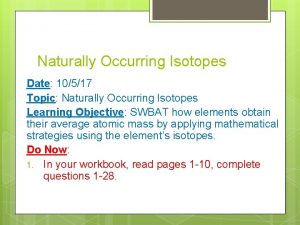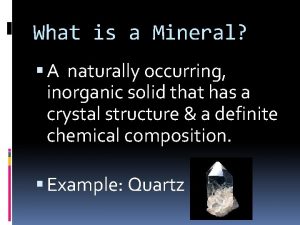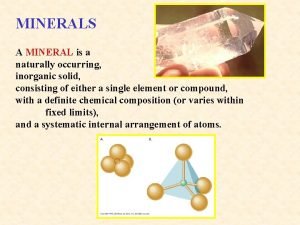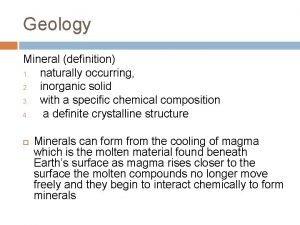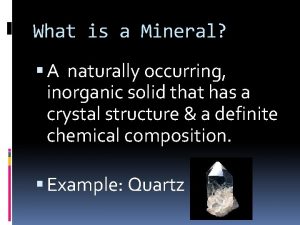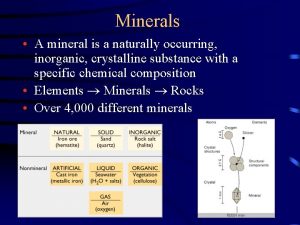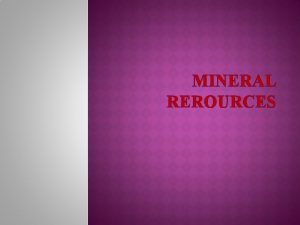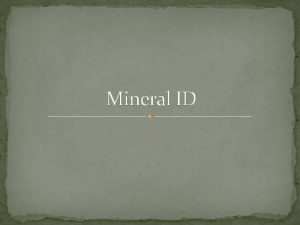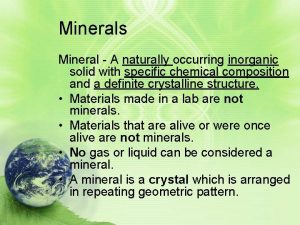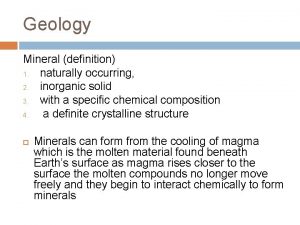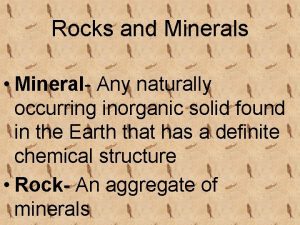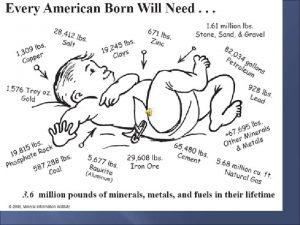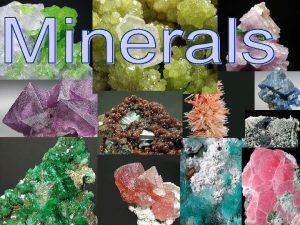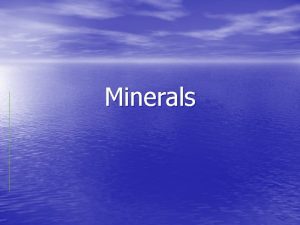What is a Mineral A naturally occurring inorganic


















- Slides: 18

What is a Mineral? A naturally occurring, inorganic solid that has a crystal structure & a definite chemical composition. Example: Quartz

Naturally Occurring: Found in nature Not man-made Forms underground

Inorganic Solid: Means the mineral cannot come from things that were once living Not a liquid or gas Non Example: Coal – it is organic because it comes from plants that lived millions of years ago.

Crystal Structure: The repeating pattern of a mineral’s particles that line up when they form. Looks like rock candy. There are 6 different crystal systems. They are categorized by the # & the angle of the crystal faces

Crystal structures look like…

6 Different Crystal Systems: Cubic Hexagonal Tetragonal Orthorhombic Monoclinic Triclinic Ex: Magnetite Ex: Quartz Ex: Rutile Ex: Sulfur Ex: Azurite Ex: Microcline Feldspar

Some examples of the crystals: Magnetite Rutile Sulfur Azurite

So what if you don’t know which mineral you have? There “tests” you can perform on minerals to see what type of mineral they might be. Physical Properties Identify Minerals. We will learn 6…

1. Streak Test The color of the mineral’s powder that’s left behind when it is rubbed across a rough surface. Ex: Pyrite looks like gold but, it’s streak looks greenish-black (aka “fool’s gold”) Writing with your pencil in class = graphite!

2. Luster Describes how light is reflected from the mineral’s surface. What does it look like? Types of luster: Metallic Ex: Galena Glassy Ex: Topaz Waxy, Greasy, Pearly Ex: Talc Dull Ex: Graphite Silky Ex: Malachite Earthy Ex: Hematite

3. Density It’s a calculation (math problem!) Use a balance to find the mass. Place the mineral in H 2 O to find the amount of water it displaces. This amount is the volume of the mineral. To find the density, divide mass by volume. Ex: Sample of Olivine �Mass = 237 g Volume = 72 cm 3 �Density = 237 g/ 72 cm 3 = 3. 3 g/cm 3


4. Cleavage One way minerals break Easily split along flat surfaces Ex: Mica & Feldspar

5. Fracture One way minerals break Break unevenly in irregular ways Chipped Shell-like Jagged points Crumbles Ex: Quartz Ex: Copper & Iron Ex: Clay

6. Mohs Hardness Scale A scale that ranks 10 minerals from softest to hardest. You can compare unknown minerals to the minerals on this scale. Hardness can be tested by a Scratch Test A mineral can scratch any other softer mineral It can also BE scratched by any harder mineral Softest Mineral = Talc Hardest Mineral = Diamond


Remember, some minerals are important parts of our food AND they are elements!

Some other common uses:
 Naturally occurring inorganic solid material
Naturally occurring inorganic solid material Naturally occurring mineral
Naturally occurring mineral Cephalin structure
Cephalin structure Renewable energy disadvantages
Renewable energy disadvantages Naturally occurring areas of hydrothermal resources
Naturally occurring areas of hydrothermal resources Naturally occurring areas of hydrothermal resources
Naturally occurring areas of hydrothermal resources H
H Largest naturally occurring element
Largest naturally occurring element Is a naturally occurring association among specific things
Is a naturally occurring association among specific things Largest naturally occurring element
Largest naturally occurring element A narrow channel or slab of a mineral
A narrow channel or slab of a mineral Inorganic mineral definition
Inorganic mineral definition What process is occurring
What process is occurring Find the probability of z occurring in the indicated region
Find the probability of z occurring in the indicated region Find the probability of z occurring in the indicated region
Find the probability of z occurring in the indicated region Organic molecules vs inorganic molecules
Organic molecules vs inorganic molecules Organic and inorganic compounds experiment
Organic and inorganic compounds experiment Non organic solvents
Non organic solvents Organic vs inorganic growth
Organic vs inorganic growth
